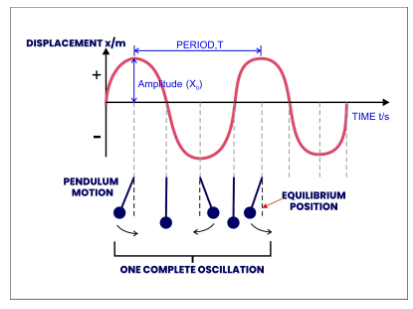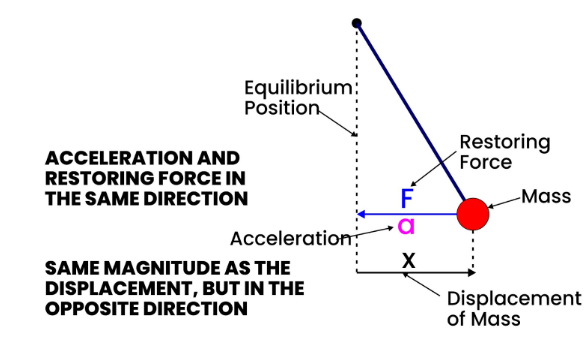Oscillations
Describing Oscillations
- To define oscillation,
It refers to the repetitive movement that occurs in a back-and-forth motion on both sides of a stable position or equilibrium point.
- After the oscillation ceases, the object will revert back to its state of equilibrium
- A vibration is a broader term, whereas oscillation is a more specific term used to describe a particular type of vibration.
- A device that operates based on the principles of oscillation is called an oscillator.
- Displacement-time graphs, resembling transverse waves, can be used to depict oscillatory systems.
- A sine curve is the shape of the graph
- The movement is characterized as sinusoidal
Properties of Oscillations
- The definition of displacement (x) in an oscillatory system is as follows:
The displacement of an oscillator is the measure of its distance from the equilibrium position
- The definition of amplitude (x0) is as follows:
Amplitude (x0) is the maximum displacement of an oscillator from its equilibrium position
- The definition of angular frequency (⍵) is as follows:
Angular frequency (⍵) refers to the measure of the rate of change of angular displacement with respect to time
- It is a scalar quantity that is quantified in rad s-1 and can be expressed using the equation:

- Frequency (f) is defined as:
The count of full oscillations within a given time interval is referred to as frequency
- The unit of measurement for frequency is Hertz (Hz), and it can be expressed mathematically by the equation:

- Time period (T) is defined as:
The duration for a single full oscillation, measured in seconds, is known as the period
- One complete oscillation is defined as:
The period is the time it takes for the oscillator to travel entirely from one side of the equilibrium position, pass it, and move back to its original position on the other side
- The time period is defined by the equation:

- Phase difference is the measurement of the extent to which one oscillator is either ahead of or behind another oscillator
- Oscillators are considered to be “in phase” when their relative positions are the same
- If one oscillator is precisely half a cycle behind another oscillator, then they are said to be in anti-phase
- Phase difference is usually quantified in radians or as a fraction of a cycle
- When two oscillators are in anti-phase, their phase difference is equal to π radians

Requirements for a system to exhibit Simple Harmonic Motion.
- An oscillation of a particular type is known as Simple Harmonic Motion (SHM).
- SHM is defined as:
When a body’s displacement is proportional to its acceleration, but in the opposite direction, it is referred to as a specific type of oscillation.
- Oscillators that exhibit Simple Harmonic Motion include the following examples:
- Quartz Crystal Oscillator
- Membrane Drum
- Violin strings
- Piano
- In order for an object to undergo Simple Harmonic Motion, it must meet the following requirements:
- Periodic oscillations
- Acceleration proportional to its displacement
- Acceleration in the opposite direction to its displacement
- The equation that defines Simple Harmonic Motion can be used to represent both acceleration (a) and displacement (x):
a ∝ −x
- An object undergoing Simple Harmonic Motion will experience a restoring force that brings it back to its equilibrium position.
- The restoring force acting on the object will be proportional to the displacement from the equilibrium position, but will act in the opposite direction.
- Please note that the restoring force and acceleration will act in the same direction

- A tuning fork is a simple oscillator that consists of a metal bar with two prongs that vibrate back and forth when struck. The motion of the prongs is an example of SHM, the reason is as follows:
- The motion of the prongs of a tuning fork is an example of SHM because it can be described by a sinusoidal function.
- As the prongs vibrate, they move back and forth along their equilibrium position, with their maximum displacement from the equilibrium position being proportional to the force that caused them to move.
- This force is provided by the strike that sets the tuning fork in motion. The prongs then oscillate around their equilibrium position with a constant amplitude and frequency, producing a pure tone of sound.
Oscillations are rhythmic movements that repeat themselves periodically around a stable equilibrium position. In A-Level Physics, oscillations are often studied in the context of simple harmonic motion, pendulums, and waves.
Simple harmonic motion is a type of oscillation where the restoring force acting on an object is directly proportional to its displacement from its equilibrium position and is always directed towards the equilibrium position.
Pendulums are a classic example of an oscillating system in A-Level Physics. A pendulum consists of a weight (or bob) attached to a rod or string, which is free to swing back and forth under the influence of gravity. The motion of a pendulum is a type of simple harmonic motion.
Waves are disturbances that propagate through a medium or space, carrying energy and momentum with them. In A-Level Physics, waves can take many forms, including sound waves, electromagnetic waves, and mechanical waves.
Transverse waves are waves where the particles of the medium vibrate perpendicular to the direction of wave propagation. Longitudinal waves are waves where the particles of the medium vibrate parallel to the direction of wave propagation.
Resonance is a phenomenon where an oscillating system is able to absorb more energy from an external source when the frequency of the external source matches the natural frequency of the system.
Oscillations have many practical applications in A-Level Physics, including in the design of mechanical systems, such as clocks and engines, and in the production and detection of waves, such as in radios and medical imaging devices.
You can improve your understanding of oscillations in A-Level Physics by practicing problems, reviewing class notes, and seeking additional resources, such as textbooks, online videos, and tutoring services. It may also be helpful to work with a study group or discuss concepts with your teacher.





Still got a question? Leave a comment
Leave a comment